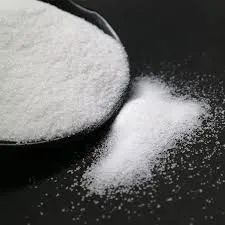Anionic Polyacrylamide Flocculant Properties, Applications, and Benefits
Anionic polyacrylamide flocculant, popularly referred to as anionic PAM, is a water-soluble polymer that plays a crucial role in various industrial applications including water treatment, mineral processing, and oil recovery. This synthetic polymer is derived from acrylamide, an organic compound that has notable properties for enhancing the flocculation process. The unique structure and characteristics of anionic PAM make it particularly effective in destabilizing colloidal suspensions and facilitating the aggregation of particles, which is essential for effective separation in many industries.
Properties of Anionic Polyacrylamide
Anionic polyacrylamide is a high molecular weight polymer, meaning that it consists of long chains of repeating monomer units. The anionic charge in this polymer comes from the presence of negatively charged carboxylate groups, which imparts unique chemical characteristics that are beneficial in various applications. The degree of anionicity can be manipulated during synthesis, allowing manufacturers to tailor the polymer's properties to specific requirements.
One of the most notable properties of anionic PAM is its ability to absorb water, enabling it to form hydrogels. This property is invaluable in applications where moisture retention or water clarification is required. Additionally, anionic PAM exhibits excellent flocculating ability, which enhances its performance in agglomerating suspended solids and reducing turbidity in water.
Applications in Water Treatment
In water treatment, anionic polyacrylamide flocculant is extensively used for clarifying drinking water, treating wastewater, and removing contaminants from industrial effluents. The flocculant promotes the agglomeration of fine particles, allowing them to settle more quickly and be separated from the water. This process not only increases the efficiency of water purification systems but also reduces the amount of chemicals needed for treatment.
Anionic PAM is particularly effective in systems with high concentrations of negatively charged particles, as the repulsive forces between like charges can hinder natural agglomeration. By introducing anionic PAM into these systems, the polymer neutralizes the surface charge of particles, facilitating the formation of larger, denser flocs that can be easily removed.
anionic polyacrylamide flocculant

Role in Mineral Processing
In the field of mineral processing, anionic polyacrylamide is also utilized as a flocculant to enhance the separation of valuable minerals from gangue materials. The addition of anionic PAM during the thickening and filtration processes improves the recovery of minerals and reduces the volume of tailings. This not only optimizes the efficiency of mineral extraction but also minimizes environmental impact by generating less waste.
Benefits of Using Anionic Polyacrylamide
The use of anionic polyacrylamide flocculant provides several benefits across various applications. Firstly, its high efficiency in flocculation leads to improved separation processes, resulting in cost savings for industries. The reduction in chemical usage not only lowers operational costs but also minimizes the environmental footprint of industrial processes by reducing the release of harmful substances.
Moreover, anionic PAM can enhance the quality of treated water, making it safer for both industrial use and human consumption. This improvement in water quality is particularly crucial in regions facing water scarcity, where effective purification methods are essential.
Conclusion
In conclusion, anionic polyacrylamide flocculant is a powerful agent that plays an integral role in various industrial processes, particularly in water treatment and mineral processing. Its unique properties enable it to effectively aggregate and separate particles, leading to enhanced operational efficiency and reduced environmental impact. As industries continue to seek sustainable and cost-effective solutions, the importance of anionic PAM is only set to grow, highlighting the need for continued research and development in this field. By leveraging the capabilities of anionic polyacrylamide, industries can achieve better operational outcomes while contributing to environmental stewardship.

